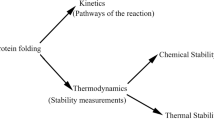Summary
The possible conformations of integral membrane proteins are restricted by the nature of their environment. In order to satisfy the requirement of maximum hydrogen bonding, those protions of the polypeptide chain which are in contact with lipid hydrocarbon must be organized into regions of regular secondary structure. As possible models of the intramembranous regions of integral membrane proteins, three types of regular structues are discussed. Two, the alpha helix and the beta-pleated sheet, are regularly occurring structural features of soluble proteins. The third is a newly proposed class of conformations called beta helices. These helices have unique features which make them particularly well-suited to the lipid bilayer environment. The central segment of the membrane-spanning protein glycophorin can be arranged into a beta helix with a hydrophobic exterior and a polar interior containing charged amino-acid side chains. Such structures could function as transmembrane ion channels. A model of the activation process based on a hypothetical equilibrium between alpha and beta helical forms of a transmembrane protein is presented. The model can accurately reproduce the kinetics and voltage dependence of the channels in nerve.
Similar content being viewed by others
References
Bamberg, E., Apell, H.J., Alpes, H. 1977. Structure of the gramicidin A channel: Distinction between the π(Loreore, d) and the β helix by electrical measurements with lipid bilayer membranes.Proc. Nat. Acad. Sci. USA 74:2402
Bezanilla, F., Armstrong, C.M. 1975. Properties of the sodium channel gating current.Cold Spring Harbor Symp. Quant. Biol. 40:297
Birktoft, J.J., Blow, D.M. 1972. Structure of crystalline α-chymotrypsin. V. The atomic structure of tosyl α-chymotrypsin at 2 Å resolution.J. Mol. Biol. 39:63
Bridgen, J., Walker, I.D. 1976. Photoreceptor protein from the purple membrane ofHalobacterium halobium. Molecular weight and retinal binding site.Biochemistry 15:792
Chothia, C.H. 1974. Hydrophobic bonding and accessible surface area in proteins.Nature (London) 248:338
Chothia, C.H. 1976. The nature of the accessible and buried surfaces in proteins.J. Mol. Biol. 105:1
Cuatrecasas, P. 1974. Membrane receptors.Annu. Rev. Biochem. 43:169
Goodall, M.C. 1973. Action of two classes of channel-forming synthetic peptide on lipid bilayers.Arch. Biochem. Biophys. 157:514
Henderson, R. 1977. The purple membrane fromHalobacterium halobium.Annu. Rev. Biophys. Bioeng. 6:87
Henderson, R., Unwin, P.N.T. 1975. Three-dimensional model of purple membrane obtained by electron microscopy.Nature (London) 257:28
Hille, B. 1975. Ionic selectivity of Na and K channels.In: Membranes. G. Eisenman, editor. Vol. 3; p. 255. Marcel Dekker, New York
Kennedy, S.J. 1976. Synthesis and characterization of membrane-active peptides having beta-helical structure: A new regular configuration proposed for polypeptide chains. Ph. D. Thesis, Indiana University, Indianapolis
Kennedy, S.J., Besch, H.R., Jr., Watanabe, A.M., Freeman, A.R., Roeske, R.W. 1977a. Properties of beta-helical ion channels.Biophys. J. 17:87a
Kennedy, S.J., Besch, H.R., Jr., Watanabe, A.M., Freeman, A.R., Roeske, R.W. 1977b. Beta-helical conformations of peptides and proteins.In: Peptides, Proceedings of the Fifth American Peptide Symposium. M. Goodman and J. Meienhofer, editors. p. 423. John Wiley & Sons, New York
Kennedy, S.J., Roeske, R.W., Freeman, A.R., Watanabe, A.M., Besch, H.R., Jr. 1977. Synthetic peptides form ion channels in artificial lipid bilayer membranes.Science 196:1341
Kuntz, I.D. 1972. Tertiary structure in carboxypeptidase.J. Am. Chem. Soc. 94:8568
Lee, B., Richards, F.M. 1971. The interpretation of protein structures: Estimation of static accessibility.J. Mol. Biol. 55:379
Liljas, A., Rossman, M.G. 1974. X-ray studies of protein interactions.Annu. Rev. Biochem. 43:475
Mathews, B.W. 1976. X-ray crystallographic studies of protiens.Annu. Rev. Phys. Chem. 27:493
Ozols, J., Gerard, C. 1977. Primary structure of the membranous segment of cytochromeb 5.Proc. Nat. Acad. Sci. USA 74:3725
Pauling, L., Corey, R.B. 1951a. The pleated sheet, a new layer configuration of polypeptide chains.Proc. Nat. Acad. Sci. USA 37:251
Pauling, L., Corey, R.B. 1951b. Configurations of polypeptide chains with favored orientation around single bonds: Two new pleated sheets.Proc. Nat. Acad. Sci. USA 37:729
Pauling, L., Corey, R.B., Branson, A.R. 1951. The structure of proteins: Two hydrogenbonded helical configurations of the polypeptide chain.Proc. Nat. Acad. Sci. USA 37:205
racker, E., Knowles, A.F., Eytan, E. 1975. Resolution and reconstitution of iontransport systems.Ann. N. Y. Acad. Sci. 264:17
Ramachandran, G.N., Chandrasekharan, R. 1972. Conformation of peptide chains containing bothLore-residues andd-residues. I. Helical structures with alternatingLore-residues andd-residues with special reference toLore,d-ribbon andLore,d-helices.Indian J. Biochem. Biophys. 9:1
Richards, F.M. 1977. Areas, volumes, packing and protein structure.Annu. Rev. Biophys. Bioeng. 6:151
Segrest, J.P., Jackson, R.L., Marchesi, V.T., Guyer, R.B., Terry, W. 1972. Red cell membrane glycoprotein: Amino acid sequence of an intramembranous region.Biochem. Biophys. Res. Commun. 49:964
Singer, S.J. 1974. The molecular organization of membranes.Annu. Rev. Biochem. 43:805
Tomita, M., Marchesi, V.T. 1975. Amino acid sequence and oligosaccharide attachment sites of human erythrocyte glycophorin.Proc. Nat. Acad. Sci. USA 72:2964
Tosteson, M.T., Tosteson, D.C. 1977. Glycophorin spans the bilayer.Biophys. J. 17:86a
Urry, D.W. 1971. The gramicidin A transmembrane channel: A proposed π(Lore,d) helix.Proc. Nat. Acad. Sci. USA 68:672
Urry, D.W. 1972. A molecular theory of ion-conducting channels: A field-dependent transition between conducting and non-conducting conformations.Proc. Nat. Acad. Sci. USA 69:1610
Urry, D.W., Goodall, M.C., Glickson, J.D., Mayers, D.F. 1971. The gramicidin A transmembrane channel: Characteristics of head-to-head dimerized. π(Lore,d) helices.Proc. Nat. Acad. Sci. USA 68:1907
Author information
Authors and Affiliations
Rights and permissions
About this article
Cite this article
Kennedy, S.J. Structures of membrane proteins. J. Membrain Biol. 42, 265–279 (1978). https://doi.org/10.1007/BF01870362
Received:
Issue Date:
DOI: https://doi.org/10.1007/BF01870362




